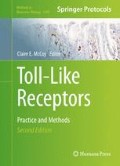Abstract
Engagement of Toll-like receptors (TLRs) on dendritic cells (DCs) triggers the expression of a large set of genes involved in DC activation and maturation, which allow them to act efficiently as antigen-presenting cells. Recently, it has become clear that TLR signalling in DCs also results in dramatic metabolic changes that are integral to their changed biology. Here, we describe a detailed protocol on how DC metabolism can be studied after TLR stimulation using the 96-well format Extracellular Flux (XFe96) Analyzer from Seahorse Bioscience, a machine that allows one to simultaneously assess rates of oxidative phosphorylation and glycolysis in real-time, in live cells and in a high-throughput manner.
Access this chapter
Tax calculation will be finalised at checkout
Purchases are for personal use only
References
Everts B, Amiel E, Huang SC et al (2014) TLR-driven early glycolytic reprogramming via the kinases TBK1-IKKvarepsilon supports the anabolic demands of dendritic cell activation. Nat Immunol 5(4):323–332
Everts B, Amiel E, van der Windt GJ et al (2012) Commitment to glycolysis sustains survival of NO-producing inflammatory dendritic cells. Blood 120(7):1422–1431
Jantsch J, Chakravortty D, Turza N et al (2008) Hypoxia and hypoxia-inducible factor-1 alpha modulate lipopolysaccharide-induced dendritic cell activation and function. J Immunol 180(7):4697–4705
Krawczyk CM, Holowka T, Sun J et al (2010) Toll-like receptor-induced changes in glycolytic metabolism regulate dendritic cell activation. Blood 115(23):4742–4749
Pantel A, Teixeira A, Haddad E et al (2014) Direct type I IFN but not MDA5/TLR3 activation of dendritic cells is required for maturation and metabolic shift to glycolysis after poly IC stimulation. PLoS Biol 12(1):e1001759
Amiel E, Everts B, Fritz D et al (2014) Mechanistic target of rapamycin inhibition extends cellular lifespan in dendritic cells by preserving mitochondrial function. J Immunol 93(6):2821–2830
Ferrick DA, Neilson A, Beeson C (2008) Advances in measuring cellular bioenergetics using extracellular flux. Drug Discov Today 13(5-6):268–274
Pearce EJ, Everts B (2015) Dendritic cell metabolism. Nat Rev Immunol 15(1):18–29
Sallusto F, Lanzavecchia A (1994) Efficient presentation of soluble antigen by cultured human dendritic cells is maintained by granulocyte/macrophage colony-stimulating factor plus interleukin 4 and downregulated by tumor necrosis factor alpha. J Exp Med 179(4):1109–1118
Lutz MB, Kukutsch N, Ogilvie AL et al (1999) An advanced culture method for generating large quantities of highly pure dendritic cells from mouse bone marrow. J Immunol Methods 223(1):77–92
Stoitzner P, Romani N, McLellan AD et al (2010) Isolation of skin dendritic cells from mouse and man. Methods Mol Biol 595:235–248
Author information
Authors and Affiliations
Corresponding author
Editor information
Editors and Affiliations
Rights and permissions
Copyright information
© 2016 Springer Science+Business Media New York
About this protocol
Cite this protocol
Pelgrom, L.R., van der Ham, A.J., Everts, B. (2016). Analysis of TLR-Induced Metabolic Changes in Dendritic Cells Using the Seahorse XFe96 Extracellular Flux Analyzer. In: McCoy, C. (eds) Toll-Like Receptors. Methods in Molecular Biology, vol 1390. Humana Press, New York, NY. https://doi.org/10.1007/978-1-4939-3335-8_17
Download citation
DOI: https://doi.org/10.1007/978-1-4939-3335-8_17
Published:
Publisher Name: Humana Press, New York, NY
Print ISBN: 978-1-4939-3333-4
Online ISBN: 978-1-4939-3335-8
eBook Packages: Springer Protocols

